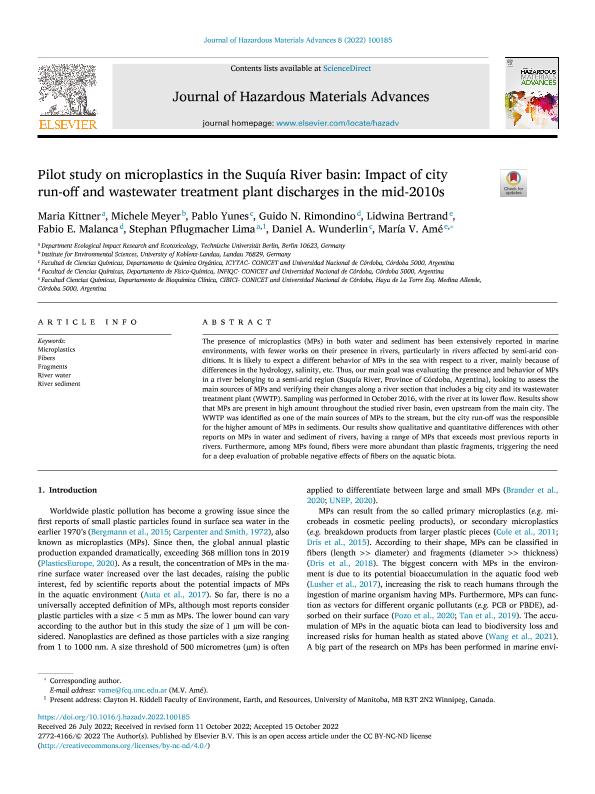Mostrar el registro sencillo del ítem
dc.contributor.author
Kittner, Maria
dc.contributor.author
Meyer, Michele
dc.contributor.author
Yunes Quartino, Pablo Javier

dc.contributor.author
Rimondino, Guido Noé

dc.contributor.author
Bertrand, Lidwina

dc.contributor.author
Malanca, Fabio Ernesto

dc.contributor.author
Pflugmacher Lima, Stephan
dc.contributor.author
Wunderlin, Daniel Alberto

dc.contributor.author
Amé, María Valeria

dc.date.available
2023-08-23T20:02:39Z
dc.date.issued
2022-10
dc.identifier.citation
Kittner, Maria; Meyer, Michele; Yunes Quartino, Pablo Javier; Rimondino, Guido Noé; Bertrand, Lidwina; et al.; Pilot study on microplastics in the Suquía River basin: Impact of city run-off and wastewater treatment plant discharges in the mid-2010s; Elsevier; Journal of Hazardous Materials Advances; 8; 10-2022; 1-12
dc.identifier.issn
2772-4166
dc.identifier.uri
http://hdl.handle.net/11336/209155
dc.description.abstract
The presence of microplastics (MPs) in both water and sediment has been extensively reported in marine environments, with fewer works on their presence in rivers, particularly in rivers affected by semi-arid conditions. It is likely to expect a different behavior of MPs in the sea with respect to a river, mainly because of differences in the hydrology, salinity, etc. Thus, our main goal was evaluating the presence and behavior of MPs in a river belonging to a semi-arid region (Suquía River, Province of Córdoba, Argentina), looking to assess the main sources of MPs and verifying their changes along a river section that includes a big city and its wastewater treatment plant (WWTP). Sampling was performed in October 2016, with the river at its lower flow. Results show that MPs are present in high amount throughout the studied river basin, even upstream from the main city. The WWTP was identified as one of the main sources of MPs to the stream, but the city run-off was the responsible for the higher amount of MPs in sediments. Our results show qualitative and quantitative differences with other reports on MPs in water and sediment of rivers, having a range of MPs that exceeds most previous reports in rivers. Furthermore, among MPs found, fibers were more abundant than plastic fragments, triggering the need for a deep evaluation of probable negative effects of fibers on the aquatic biota.
dc.format
application/pdf
dc.language.iso
eng
dc.publisher
Elsevier

dc.rights
info:eu-repo/semantics/openAccess
dc.rights.uri
https://creativecommons.org/licenses/by-nc-nd/2.5/ar/
dc.subject
MICROPLASTICS
dc.subject
FIBERS
dc.subject
FRAGMENTS
dc.subject
RIVER WATER
dc.subject
RIVER SEDIMENTS
dc.subject.classification
Otras Ciencias de la Tierra y relacionadas con el Medio Ambiente

dc.subject.classification
Ciencias de la Tierra y relacionadas con el Medio Ambiente

dc.subject.classification
CIENCIAS NATURALES Y EXACTAS

dc.title
Pilot study on microplastics in the Suquía River basin: Impact of city run-off and wastewater treatment plant discharges in the mid-2010s
dc.type
info:eu-repo/semantics/article
dc.type
info:ar-repo/semantics/artículo
dc.type
info:eu-repo/semantics/publishedVersion
dc.date.updated
2023-07-07T18:55:51Z
dc.journal.volume
8
dc.journal.pagination
1-12
dc.journal.pais
Países Bajos

dc.journal.ciudad
Amsterdam
dc.description.fil
Fil: Kittner, Maria. Technishe Universitat Berlin; Alemania
dc.description.fil
Fil: Meyer, Michele. Universitat Koblenz; Alemania
dc.description.fil
Fil: Yunes Quartino, Pablo Javier. Consejo Nacional de Investigaciones Científicas y Técnicas. Centro Científico Tecnológico Conicet - Córdoba. Instituto de Ciencia y Tecnología de Alimentos Córdoba. Universidad Nacional de Córdoba. Facultad de Ciencias Químicas. Instituto de Ciencia y Tecnología de Alimentos Córdoba; Argentina
dc.description.fil
Fil: Rimondino, Guido Noé. Consejo Nacional de Investigaciones Científicas y Técnicas. Centro Científico Tecnológico Conicet - Córdoba. Instituto de Investigaciones en Físico-química de Córdoba. Universidad Nacional de Córdoba. Facultad de Ciencias Químicas. Instituto de Investigaciones en Físico-química de Córdoba; Argentina
dc.description.fil
Fil: Bertrand, Lidwina. Consejo Nacional de Investigaciones Científicas y Técnicas. Centro Científico Tecnológico Córdoba. Centro de Investigaciones en Bioquímica Clínica e Inmunología; Argentina
dc.description.fil
Fil: Malanca, Fabio Ernesto. Consejo Nacional de Investigaciones Científicas y Técnicas. Centro Científico Tecnológico Conicet - Córdoba. Instituto de Investigaciones en Físico-química de Córdoba. Universidad Nacional de Córdoba. Facultad de Ciencias Químicas. Instituto de Investigaciones en Físico-química de Córdoba; Argentina
dc.description.fil
Fil: Pflugmacher Lima, Stephan. Technishe Universitat Berlin; Alemania. University of Manitoba; Canadá
dc.description.fil
Fil: Wunderlin, Daniel Alberto. Consejo Nacional de Investigaciones Científicas y Técnicas. Centro Científico Tecnológico Conicet - Córdoba. Instituto de Ciencia y Tecnología de Alimentos Córdoba. Universidad Nacional de Córdoba. Facultad de Ciencias Químicas. Instituto de Ciencia y Tecnología de Alimentos Córdoba; Argentina
dc.description.fil
Fil: Amé, María Valeria. Consejo Nacional de Investigaciones Científicas y Técnicas. Centro Científico Tecnológico Córdoba. Centro de Investigaciones en Bioquímica Clínica e Inmunología; Argentina
dc.journal.title
Journal of Hazardous Materials Advances
dc.relation.alternativeid
info:eu-repo/semantics/altIdentifier/url/https://www.sciencedirect.com/science/article/pii/S2772416622001413
dc.relation.alternativeid
info:eu-repo/semantics/altIdentifier/doi/https://doi.org/10.1016/j.hazadv.2022.100185
Archivos asociados
